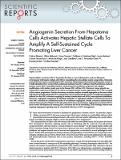Por favor, use este identificador para citar o enlazar a este item:
http://hdl.handle.net/10261/124524COMPARTIR / EXPORTAR:
 SHARE SHARE
 CORE
BASE CORE
BASE
|
|
| Visualizar otros formatos: MARC | Dublin Core | RDF | ORE | MODS | METS | DIDL | DATACITE | |

| Campo DC | Valor | Lengua/Idioma |
|---|---|---|
| dc.contributor.author | Bárcena, Cristina | - |
| dc.contributor.author | Stefanovic, Milica | - |
| dc.contributor.author | Tutusaus, Anna | - |
| dc.contributor.author | Martínez-Nieto, Guillermo A. | - |
| dc.contributor.author | Martínez, Laura | - |
| dc.contributor.author | García-Ruiz, Carmen | - |
| dc.contributor.author | Mingo, Álvaro de | - |
| dc.contributor.author | Caballería, Juan | - |
| dc.contributor.author | Fernández-Checa, José C. | - |
| dc.contributor.author | Marí, Montserrat | - |
| dc.contributor.author | Morales, Albert | - |
| dc.date.accessioned | 2015-11-05T11:06:48Z | - |
| dc.date.available | 2015-11-05T11:06:48Z | - |
| dc.date.issued | 2015-01-21 | - |
| dc.identifier | doi: 10.1038/srep07916 | - |
| dc.identifier | issn: 2045-2322 | - |
| dc.identifier.citation | Scientific Reports 5: 7916 (2015) | - |
| dc.identifier.uri | http://hdl.handle.net/10261/124524 | - |
| dc.description.abstract | Hepatocellular carcinoma (HCC) frequently develops in a pro-inflammatory and pro-fibrogenic environment with hepatic stellate cells (HSCs) remodeling the extracellular matrix composition. Molecules secreted by liver tumors contributing to HSC activation and peritumoral stromal transformation remain to be fully identified. Here we show that conditioned medium from HCC cell lines, Hep3B and HepG2, induced primary mouse HSCs transdifferentiation, characterized by profibrotic properties and collagen modification, with similar results seen in the human HSC cell line LX2. Moreover, tumor growth was enhanced by coinjection of HepG2/LX2 cells in a xenograft murine model, supporting a HCC-HSC crosstalk in liver tumor progression. Protein microarray secretome analyses revealed angiogenin as the most robust and selective protein released by HCC compared to LX2 secreted molecules. In fact, recombinant angiogenin induced in vitro HSC activation requiring its nuclear translocation and rRNA transcriptional stimulation. Moreover, angiogenin antagonism by blocking antibodies or angiogenin inhibitor neomycin decreased in vitro HSC activation by conditioned media or recombinant angiogenin. Finally, neomycin administration reduced tumor growth of HepG2-LX2 cells coinjected in mice. In conclusion, angiogenin secretion by HCCs favors tumor development by inducing HSC activation and ECM remodeling. These findings indicate that targeting angiogenin signaling may be of potential relevance in HCC management | - |
| dc.description.sponsorship | This study was funded by grants from the Instituto de Salud Carlos III (FIS PI12/00110, PI09/00056 to A.M., FIS PI10/02114, PI13/00374 to M.M., PI12/01265 to J.C. and PI11/0325 to J.F.C.), Ministerio de Economía y Competitividad (SAF 2012/34831 to J.F.C. and SAF2011-23031 to C.G.R.) and co-funded by FEDER (Fondo Europeo de Desarrollo Regional, Unión Europea. “Una manera de hacer Europa”); center grant P50-AA-11999 from Research Center for Liver and Pancreatic Diseases, US NIAAA to J.F.C.); Fundació la Marató de TV3 to J.F.C., Mutua Madrilea (AP103502012) to C.G.R., and by CIBERehd from the Instituto de Salud Carlos III | - |
| dc.publisher | Nature Publishing Group | - |
| dc.relation.isversionof | Publisher's version | - |
| dc.rights | openAccess | - |
| dc.title | Angiogenin secretion from hepatoma cells activates hepatic stellate cells to amplify a self-sustained cycle promoting liver cancer | - |
| dc.type | artículo | - |
| dc.identifier.doi | 10.1038/srep07916 | - |
| dc.relation.publisherversion | http://dx.doi.org/10.1038/srep07916 | - |
| dc.date.updated | 2015-11-05T11:06:48Z | - |
| dc.description.version | Peer Reviewed | - |
| dc.language.rfc3066 | eng | - |
| dc.rights.license | http://creativecommons.org/licenses/by-nc-nd/4.0/ | - |
| dc.contributor.funder | National Institute on Alcohol Abuse and Alcoholism (US) | - |
| dc.contributor.funder | European Commission | - |
| dc.contributor.funder | Ministerio de Economía y Competitividad (España) | - |
| dc.contributor.funder | Instituto de Salud Carlos III | - |
| dc.relation.csic | Sí | - |
| dc.identifier.funder | http://dx.doi.org/10.13039/100000027 | es_ES |
| dc.identifier.funder | http://dx.doi.org/10.13039/501100000780 | es_ES |
| dc.identifier.funder | http://dx.doi.org/10.13039/501100003329 | es_ES |
| dc.identifier.funder | http://dx.doi.org/10.13039/501100004587 | es_ES |
| dc.identifier.pmid | 25604905 | - |
| dc.type.coar | http://purl.org/coar/resource_type/c_6501 | es_ES |
| item.openairetype | artículo | - |
| item.grantfulltext | open | - |
| item.cerifentitytype | Publications | - |
| item.openairecristype | http://purl.org/coar/resource_type/c_18cf | - |
| item.fulltext | With Fulltext | - |
| Aparece en las colecciones: | (IIBB) Artículos | |
Ficheros en este ítem:
| Fichero | Descripción | Tamaño | Formato | |
|---|---|---|---|---|
| Barcena-Scientific-Reports-2015-7916.pdf | 1,49 MB | Adobe PDF |  Visualizar/Abrir |
CORE Recommender
PubMed Central
Citations
23
checked on 17-abr-2024
SCOPUSTM
Citations
43
checked on 19-abr-2024
WEB OF SCIENCETM
Citations
37
checked on 24-feb-2024
Page view(s)
358
checked on 23-abr-2024
Download(s)
310
checked on 23-abr-2024

